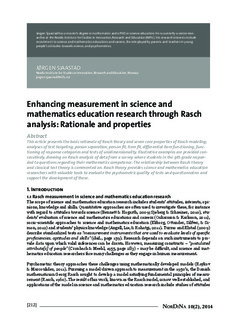| dc.contributor.author | Sjaastad, Jørgen | |
| dc.date.accessioned | 2015-02-05T10:20:45Z | |
| dc.date.accessioned | 2015-02-09T09:37:11Z | |
| dc.date.available | 2015-02-05T10:20:45Z | |
| dc.date.available | 2015-02-09T09:37:11Z | |
| dc.date.issued | 2014 | |
| dc.identifier.citation | NorDiNa : Nordic Studies in Science Education 2014, 10(2):212-230 | |
| dc.identifier.issn | 1504-4556 | |
| dc.identifier.uri | http://hdl.handle.net/11250/275608 | |
| dc.description.abstract | This article presents the basic rationale of Rasch theory and seven core properties of Rasch modeling; analyses of test targeting, person separation, person fit, item fit, differential item functioning, functioning of response categories and tests of unidimensionality. Illustrative examples are provided consecutively, drawing on Rasch analysis of data from a survey where students in the 9th grade responded to questions regarding their mathematics competence. The relationship between Rasch theory and classical test theory is commented on. Rasch theory provides science and mathematics education researchers with valuable tools to evaluate the psychometric quality of tests and questionnaires and support the development of these. | en |
| dc.language.iso | eng | |
| dc.relation.uri | https://www.journals.uio.no/index.php/nordina/article/view/662 | |
| dc.title | Enhancing measurement in science and mathematics education through Rasch analysis: Rationale and properties | |
| dc.type | Journal article | |
| dc.type | Peer reviewed | |
| dc.date.updated | 2015-02-05T10:20:45Z | |
| dc.identifier.cristin | 1185593 | |
